欧盟 食品包装印刷油墨指南
- 格式:pdf
- 大小:194.32 KB
- 文档页数:16
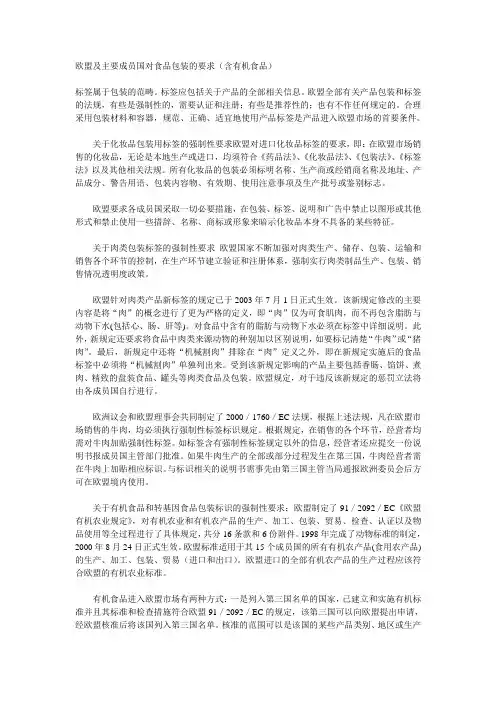
欧盟及主要成员国对食品包装的要求(含有机食品)标签属于包装的范畴。
标签应包括关于产品的全部相关信息。
欧盟全部有关产品包装和标签的法规,有些是强制性的,需要认证和注册;有些是推荐性的;也有不作任何规定的。
合理采用包装材料和容器,规范、正确、适宜地使用产品标签是产品进入欧盟市场的首要条件。
关于化妆品包装用标签的强制性要求欧盟对进口化妆品标签的要求,即:在欧盟市场销售的化妆品,无论是本地生产或进口,均须符合《药品法》、《化妆品法》、《包装法》、《标签法》以及其他相关法规。
所有化妆品的包装必须标明名称、生产商或经销商名称及地址、产品成分、警告用语、包装内容物、有效期、使用注意事项及生产批号或鉴别标志。
欧盟要求各成员国采取一切必要措施,在包装、标签、说明和广告中禁止以图形或其他形式和禁止使用一些措辞、名称、商标或形象来暗示化妆品本身不具备的某些特征。
关于肉类包装标签的强制性要求欧盟国家不断加强对肉类生产、储存、包装、运输和销售各个环节的控制,在生产环节建立验证和注册体系,强制实行肉类制品生产、包装、销售情况透明度政策。
欧盟针对肉类产品新标签的规定已于2003年7月1日正式生效。
该新规定修改的主要内容是将“肉”的概念进行了更为严格的定义,即“肉”仅为可食肌肉,而不再包含脂肪与动物下水(包括心、肠、肝等)。
对食品中含有的脂肪与动物下水必须在标签中详细说明。
此外,新规定还要求将食品中肉类来源动物的种别加以区别说明,如要标记清楚“牛肉”或“猪肉”。
最后,新规定中还将“机械割肉”排除在“肉”定义之外,即在新规定实施后的食品标签中必须将“机械割肉”单独列出来。
受到该新规定影响的产品主要包括香肠、馅饼、煮肉、精致的盘装食品、罐头等肉类食品及包装。
欧盟规定,对于违反该新规定的惩罚立法将由各成员国自行进行。
欧洲议会和欧盟理事会共同制定了2000/1760/EC法规,根据上述法规,凡在欧盟市场销售的牛肉,均必须执行强制性标签标识规定。
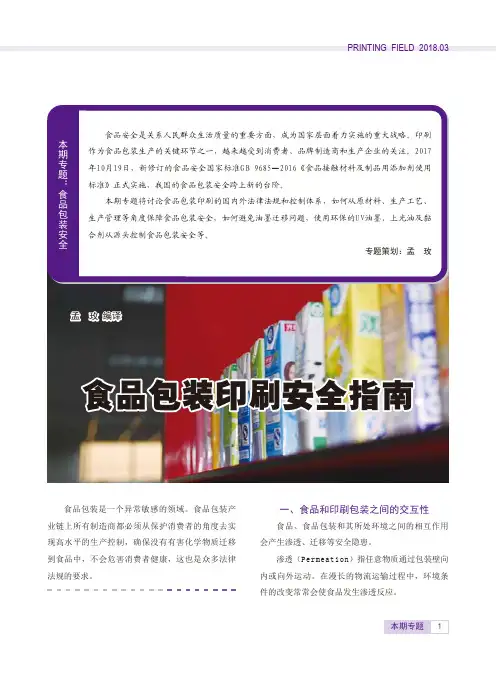
PRINTING FIELD 2018.03食品安全是关系人民群众生活质量的重要方面,成为国家层面着力实施的重大战略。
印刷作为食品包装生产的关键环节之一,越来越受到消费者、品牌制造商和生产企业的关注。
2017年10月19日,新修订的食品安全国家标准G B 9685—2016《食品接触材料及制品用添加剂使用标准》正式实施,我国的食品包装安全跨上新的台阶。
本期专题将讨论食品包装印刷的国内外法律法规和控制体系,如何从原材料、生产工艺、生产管理等角度保障食品包装安全,如何避免油墨迁移问题,使用环保的U V油墨、上光油及黏合剂从源头控制食品包装安全等。
专题策划:孟 玫本期专题:食品包装安全食品包装是一个异常敏感的领域。
食品包装产业链上所有制造商都必须从保护消费者的角度去实现高水平的生产控制,确保没有有害化学物质迁移到食品中,不会危害消费者健康,这也是众多法律法规的要求。
食品包装印刷安全指南一、食品和印刷包装之间的交互性食品、食品包装和其所处环境之间的相互作用会产生渗透、迁移等安全隐患。
渗透(Permeation)指任意物质通过包装壁向内或向外运动。
在漫长的物流运输过程中,环境条件的改变常常会使食品发生渗透反应。
孟 玫 编译迁移(M i g r a t i o n)是指物质从包装向食品转移,或者从食品向包装转移。
这是向食品相关制造商供应材料(包括油墨、包装材料、复合黏合剂、标签底胶等)时的主要担忧,必须严格控制。
广义地讲,迁移包括渗透、接触、挥发和凝结所产生的物质运动。
表1是迁移发生的四种主要途径。
法律法规中允许的最大迁移量,根据浓度的不同,常常用每6 d m 2的包装中多少毫克,或每千克食品中多少毫克,或每百万中多少单位,或每十亿中多少单位表示。
这些数值通过精密化学分析获得。
发生迁移的来源有哪些?食品包装印刷品上可能发生迁移的来源,包括其生产加工和运输储藏过程中使用和接触到的印刷设备、承印材料、油墨和上光油及黏合剂等,以及环境的影响。
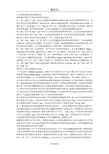
出口欧盟美国食品包装的要求欧盟(欧共体)关于食品包装的技术法规76/211/EEC关于统一各成员国按确定的重量或容量预包装产品的法律的理事会指令。
该指令是比较实用和覆盖面广的技术法规。
按确定的重量或容量,指包装或标签标示的量。
范围在不小于5g或5ml,不大于10kg或10L之间。
实际的量允许有误差,但有限度。
维护消费者的利益属于基本要求的范畴,由指令直接规定产品的质和量是顺理成章的。
90/496/EEC和2003/120/EC关于食品营养标签的理事会指令。
关于食品营养标签的理事会指令和关于90/496/EEC食品营养标签的修正案,是对营养食品的基本要求。
规范的标签是产品进入欧盟市场的首要条件。
关于一般食品标签见第五章。
89/109/EEC、2002/72/EC等关于与食品接触的包装材料的理事会指令。
与食品接触的包装材料主要受关注的是塑料,其次是纸。
在欧盟,玻璃和金属被认为是惰性的(实际上是这方面的技术成熟)。
关于与食品接触的出口包装材料,欧盟的相关法令很多。
89/109/EEC提出了总体要求,其中有两个具体的转移类型,允许透过极限为60mg/1kg(60mg的任何物质、lkg的食品)。
2002/72/EC的颁布,全部取代了90/128/EEC和7个修正案,并且修订了2002/17/EC,对转移采取了与89/109/EEC不同的量纲,并且特别关注与薄膜复合的材料,允许透过极限为l0mg/dm2(10mg的任何物质、1dm2的包装材料)。
82/711/EEC中规定了测试方法。
欧盟法令对PVC没有规定具体的转移量,但78/142/EEC规定了食品包装材料氯乙烯单体允许量为0.701mg/kg,80/766/EEC规定了检测方法。
美国关于食品包装的技术法规《公示法案》(ModelLegislation)。
2004年10月美国官方正式公布修订的公示法案《包装中的毒物》(Toxi-csinpackaging),该法案持有与欧共体相同的观点,规定了与欧盟94/62/EC 和其修正案2004/12/EC相同的技术指标,提出了特殊的规定。
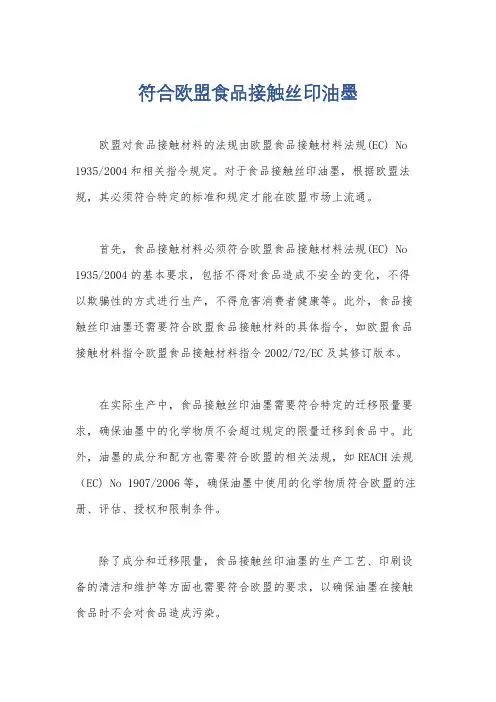
符合欧盟食品接触丝印油墨
欧盟对食品接触材料的法规由欧盟食品接触材料法规(EC) No 1935/2004和相关指令规定。
对于食品接触丝印油墨,根据欧盟法规,其必须符合特定的标准和规定才能在欧盟市场上流通。
首先,食品接触材料必须符合欧盟食品接触材料法规(EC) No 1935/2004的基本要求,包括不得对食品造成不安全的变化,不得以欺骗性的方式进行生产,不得危害消费者健康等。
此外,食品接触丝印油墨还需要符合欧盟食品接触材料的具体指令,如欧盟食品接触材料指令欧盟食品接触材料指令2002/72/EC及其修订版本。
在实际生产中,食品接触丝印油墨需要符合特定的迁移限量要求,确保油墨中的化学物质不会超过规定的限量迁移到食品中。
此外,油墨的成分和配方也需要符合欧盟的相关法规,如REACH法规(EC) No 1907/2006等,确保油墨中使用的化学物质符合欧盟的注册、评估、授权和限制条件。
除了成分和迁移限量,食品接触丝印油墨的生产工艺、印刷设备的清洁和维护等方面也需要符合欧盟的要求,以确保油墨在接触食品时不会对食品造成污染。
总之,食品接触丝印油墨需要符合欧盟食品接触材料法规的基
本要求,同时还需要满足特定的迁移限量、成分、生产工艺等要求,才能在欧盟市场上合法流通和使用。
制造商在生产和销售食品接触
丝印油墨时,应当严格遵守欧盟的相关法规和标准,确保产品的安
全性和合规性。
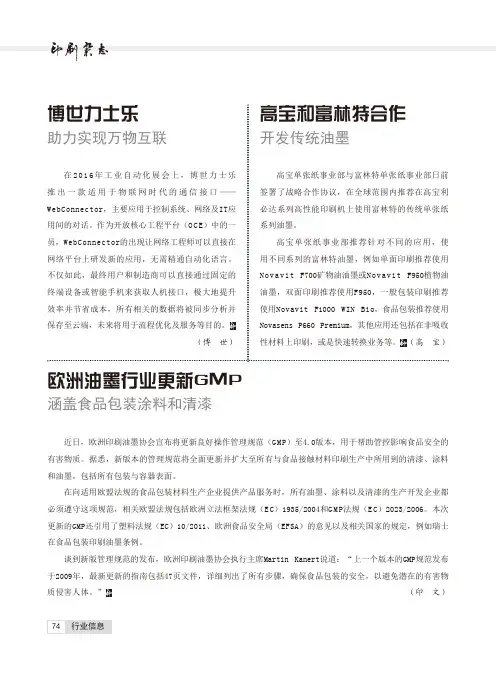
博世力士乐助力实现万物互联在2016年工业自动化展会上,博世力士乐推出一款适用于物联网时代的通信接口——WebConnector,主要应用于控制系统、网络及IT应用间的对话。
作为开放核心工程平台(O C E)中的一员,WebConnector的出现让网络工程师可以直接在网络平台上研发新的应用,无需精通自动化语言。
不仅如此,最终用户和制造商可以直接通过固定的终端设备或智能手机来获取人机接口,极大地提升效率并节省成本,所有相关的数据将被同步分析并保存至云端,未来将用于流程优化及服务等目的。
(博 世)高宝和富林特合作开发传统油墨高宝单张纸事业部与富林特单张纸事业部日前签署了战略合作协议,在全球范围内推荐在高宝利必达系列高性能印刷机上使用富林特的传统单张纸系列油墨。
高宝单张纸事业部推荐针对不同的应用,使用不同系列的富林特油墨,例如单面印刷推荐使用Novavit F700矿物油油墨或Novavit F950植物油油墨,双面印刷推荐使用F950,一般包装印刷推荐使用Novavit F1000 WIN Bio,食品包装推荐使用Novasens P660 Premium,其他应用还包括在非吸收性材料上印刷,或是快速转换业务等。
(高 宝)欧洲油墨行业更新GMP涵盖食品包装涂料和清漆近日,欧洲印刷油墨协会宣布将更新良好操作管理规范(GMP)至4.0版本,用于帮助管控影响食品安全的有害物质。
据悉,新版本的管理规范将全面更新并扩大至所有与食品接触材料印刷生产中所用到的清漆、涂料和油墨,包括所有包装与容器表面。
在向适用欧盟法规的食品包装材料生产企业提供产品服务时,所有油墨、涂料以及清漆的生产开发企业都必须遵守这项规范,相关欧盟法规包括欧洲立法框架法规(E C)1935/2004和G M P法规(E C)2023/2006。
本次更新的GMP还引用了塑料法规(EC)10/2011、欧洲食品安全局(EFSA)的意见以及相关国家的规定,例如瑞士在食品包装印刷油墨条例。

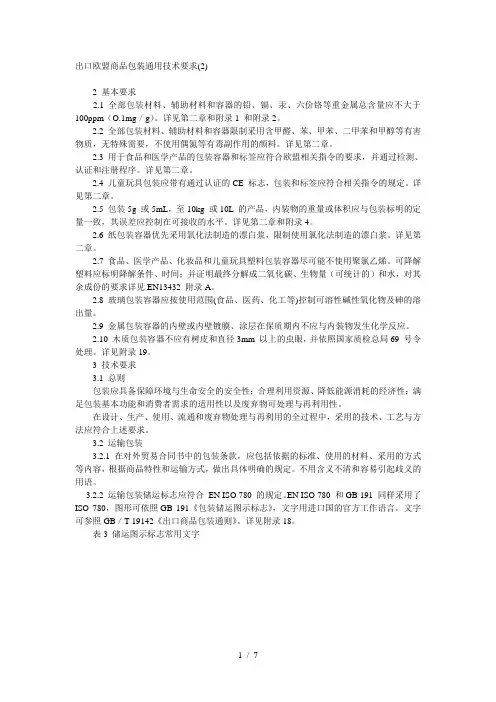
出口欧盟商品包装通用技术要求(2)2 基本要求2.1 全部包装材料、辅助材料和容器的铅、镉、汞、六价铬等重金属总含量应不大于100ppm(O.1mg/g)。
详见第二章和附录1 和附录2。
2.2 全部包装材料、辅助材料和容器限制采用含甲醛、苯、甲苯、二甲苯和甲醇等有害物质,无特殊需要,不使用偶氮等有毒副作用的颜料。
详见第二章。
2.3 用于食品和医学产品的包装容器和标签应符合欧盟相关指令的要求,并通过检测、认证和注册程序。
详见第二章。
2.4 儿童玩具包装应带有通过认证的CE 标志,包装和标签应符合相关指令的规定。
详见第二章。
2.5 包装5g 或5mL,至10kg 或10L 的产品,内装物的重量或体积应与包装标明的定量一致,其误差应控制在可接收的水平。
详见第二章和附录4。
2.6 纸包装容器优先采用氧化法制造的漂白浆,限制使用氯化法制造的漂白浆。
详见第二章。
2.7 食品、医学产品、化妆品和儿童玩具塑料包装容器尽可能不使用聚氯乙烯。
可降解塑料应标明降解条件、时间;并证明最终分解成二氧化碳、生物量(可统计的)和水,对其余成份的要求详见EN13432 附录A。
2.8 玻璃包装容器应按使用范围(食品、医药、化工等)控制可溶性碱性氧化物及砷的溶出量。
2.9 金属包装容器的内壁或内壁镀膜、涂层在保质期内不应与内装物发生化学反应。
2.10 木质包装容器不应有树皮和直径3mm 以上的虫眼,并依照国家质检总局69 号令处理。
详见附录19。
3 技术要求3.1 总则包装应具备保障环境与生命安全的安全性;合理利用资源、降低能源消耗的经济性;满足包装基本功能和消费者需求的适用性以及废弃物可处理与再利用性。
在设计、生产、使用、流通和废弃物处理与再利用的全过程中,采用的技术、工艺与方法应符合上述要求。
3.2 运输包装3.2.1 在对外贸易合同书中的包装条款,应包括依据的标准、使用的材料、采用的方式等内容,根据商品特性和运输方式,做出具体明确的规定。
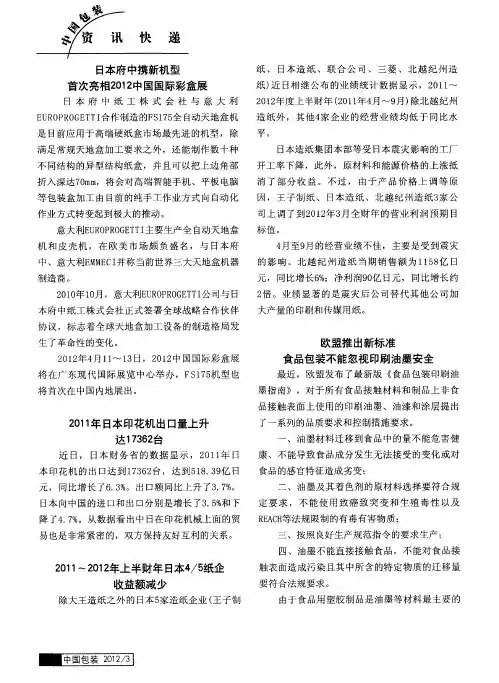
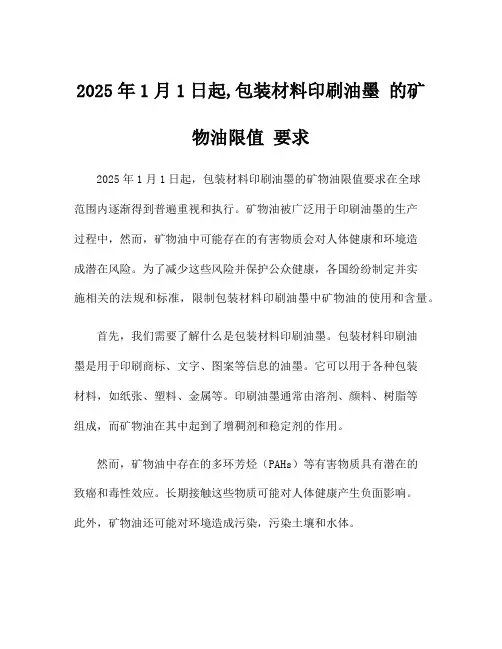
2025年1月1日起,包装材料印刷油墨的矿物油限值要求2025年1月1日起,包装材料印刷油墨的矿物油限值要求在全球范围内逐渐得到普遍重视和执行。
矿物油被广泛用于印刷油墨的生产过程中,然而,矿物油中可能存在的有害物质会对人体健康和环境造成潜在风险。
为了减少这些风险并保护公众健康,各国纷纷制定并实施相关的法规和标准,限制包装材料印刷油墨中矿物油的使用和含量。
首先,我们需要了解什么是包装材料印刷油墨。
包装材料印刷油墨是用于印刷商标、文字、图案等信息的油墨。
它可以用于各种包装材料,如纸张、塑料、金属等。
印刷油墨通常由溶剂、颜料、树脂等组成,而矿物油在其中起到了增稠剂和稳定剂的作用。
然而,矿物油中存在的多环芳烃(PAHs)等有害物质具有潜在的致癌和毒性效应。
长期接触这些物质可能对人体健康产生负面影响。
此外,矿物油还可能对环境造成污染,污染土壤和水体。
为了解决这些问题,许多国家和地区已经制定了一系列法规和标准来限制包装材料印刷油墨中矿物油的使用和含量。
这些法规和标准通常包括两个方面的要求:限制矿物油的使用量和调整矿物油的成分。
首先,限制矿物油的使用量是通过设定矿物油的限值来实现的。
限值可以是总矿物油含量也可以是特定成分的含量。
例如,欧盟对食品接触材料中矿物油的限值要求是10毫克/千克。
这意味着食品包装材料印刷油墨中的矿物油总量不得超过10毫克/千克。
其次,调整矿物油的成分也是一种解决方案。
一些国家和地区要求使用特定的替代品或限制特定成分的含量,例如限制多环芳烃(PAHs)等有害物质的含量。
这样可以确保印刷油墨的安全性和环境友好性。
这些法规和标准的实施对于提高包装材料印刷油墨的安全性和环境友好性具有重要意义。
它们可以降低人们接触有害物质的风险,减少环境污染和生态破坏。
然而,由于国家和地区之间的法规和标准存在差异,全球包装材料印刷油墨行业仍然面临着挑战。
针对这一问题,国际间的合作和标准的推动非常重要。
各国和地区应该加强信息交流和合作,分享经验和最佳实践,以推动整个行业的可持续发展。

工艺 技术 张莉 必维申美商品检测(上海)有限公司青岛分公司 张婷婷 山东大学 董振方 上海凯来实验设备有限公司油墨在食品接触材料中的使用及欧洲市场的管理思路2023/2006明确提出油墨不可使用在食品接触面。
生产企业应采取措施限制油墨通过穿透基材和蹭脏而迁移到食品接触面。
欧盟没有出台专门针对油墨的法规。
但是一些其他的细分法规为油墨合规提供了可能。
如,有些油墨的成分在EU 10/2011的许可列表内。
如果塑料FCM使用含有这种成分的油墨,成品状态下,该成分的迁移能符合相关的限值(除非还有其他的限制),该成分的使用可以认为是安全的。
成员国法规。
虽然欧盟层面没有统一的管理油墨的法规,但少量成员国发布了本国的管控法规,例如罗马尼亚(Ministerial Order No. 869/2006),捷克(Decree no. 38/2001),荷兰(Dutch Packaging and Utensils Regulations)等。
同时如荷兰专门对着色剂的使用提出了本国的要求。
其他欧洲国家法规。
虽然瑞士不是欧盟成员国,但是其法规由于可操作性强,并且能给消费者带来更好的保护,在印刷油墨行业相当有影响力。
SR 817.023.21除了提出特殊迁移的重金属和基础芳香胺的要求(同EU塑料),还提供了两个许可物质列表。
经过毒理评估的许可物质被归纳在列表A内。
A表内的物质可能有特殊迁移限值和其他的要求。
如果无特别的要求,其特殊迁移不能超过60mg/kg。
未经过毒理评估的许可物质被列在列表B内。
B表内的物质可以合法使用,但是其特殊迁移不能超过0.1mg/kg(相当于基材是有效隔断层)。
值得一提的是,瑞士法规除了为着色剂、连结料、载体、添加剂每种单列一个子章节,还特别列出了光引发剂。
非政府机构。
在印刷油墨这个领域,欧洲影响力最大的NGO是欧洲印刷油墨协会(EuPIA)。
其发布的指引被广大油墨生产、使用企业所接受。
其管控的思路如下(1)首先看该成分是否被现有的食品接触材料法规所许可(如EU 10/2011,德国BfR推荐等)。
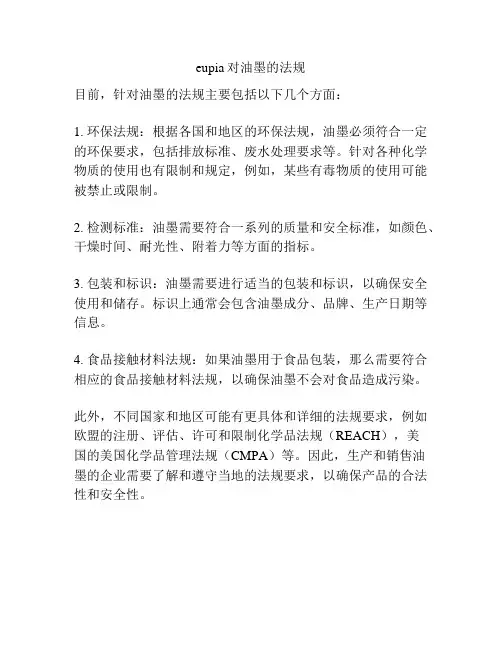
eupia对油墨的法规
目前,针对油墨的法规主要包括以下几个方面:
1. 环保法规:根据各国和地区的环保法规,油墨必须符合一定的环保要求,包括排放标准、废水处理要求等。
针对各种化学物质的使用也有限制和规定,例如,某些有毒物质的使用可能被禁止或限制。
2. 检测标准:油墨需要符合一系列的质量和安全标准,如颜色、干燥时间、耐光性、附着力等方面的指标。
3. 包装和标识:油墨需要进行适当的包装和标识,以确保安全使用和储存。
标识上通常会包含油墨成分、品牌、生产日期等信息。
4. 食品接触材料法规:如果油墨用于食品包装,那么需要符合相应的食品接触材料法规,以确保油墨不会对食品造成污染。
此外,不同国家和地区可能有更具体和详细的法规要求,例如欧盟的注册、评估、许可和限制化学品法规(REACH),美
国的美国化学品管理法规(CMPA)等。
因此,生产和销售油
墨的企业需要了解和遵守当地的法规要求,以确保产品的合法性和安全性。
食品级油墨安全要求标准什么是食品级油墨?食品级油墨,顾名思义,是用于食品包装或食品直接接触的油墨,需要符合安全标准,不会对人体健康造成风险。
通常由颜料、溶剂和添加剂组成,能够印刷在食品包装或直接接触食品的产品表面,包括糖果、果汁、罐头、牛奶、饼干等。
食品级油墨的安全要求为了保证油墨不会对人体健康造成风险,在制定食品级油墨标准时,涉及到的因素有以下几点:1. 不含有毒物质食品级油墨不应含有有害物质,如铅、镉、汞、铬等有毒重金属和邻苯二甲酸酯等有害物质。
这些物质会在印刷时释放出来,残留在食品包装材料或直接接触食品的表面,进入人体健康有风险。
2. 具有稳定性食品级油墨必须具有一定的稳定性,能够在食品包装或直接接触食品的表面长时间存在且不会发生化学反应,避免食品和包装材料之间出现某种变化,例如变质、变色等。
3. 符合国际标准食品级油墨应符合相应的国际标准,如欧洲联盟的欧盟2002/72/EC指令、美国FDA (美国食品和药物管理局)的21 CFR规定等。
符合国际标准的食品级油墨,能够进入更广泛的市场,受到更多人的认可和信任。
4. 在印刷时的安全性在使用食品级油墨时,必须考虑到其安全性。
在印刷过程中,油墨应具有良好的附着性和光泽度,能够形成清晰、美观的印刷效果。
同时也不能出现掉色、脱落等现象。
食品级油墨的生产和使用食品级油墨的生产和使用需要严格遵守相关的标准和法规,并且需要针对不同的食品包装和直接接触食品的材料选择不同的油墨种类和配方。
此外,生产和使用过程中的卫生和安全要求也不能忽视,如制造环境的卫生水平、工作人员的衛生、生产设备的清洁程度、生产工艺等。
结论食品级油墨是保障食品安全的重要环节,具有相应的安全要求。
生产和使用食品级油墨,需要严格遵守相关的标准和法规以及注重生产和使用过程中的卫生和安全要求。
与此同时,消费者在购买包含食品级油墨的食品产品时,应仔细阅读包装说明,确保购买的食品产品符合食品安全标准。
印刷油墨reach检测标准
印刷油墨在欧盟市场上需要符合REACH(Registration, Evaluation, Authorization and Restriction of Chemicals)的标准。
REACH是欧盟制定的化学品管理法规,旨在确保化学品的安全使用,并保护人类健康和环境。
对于印刷油墨,REACH标准涉及到油墨中所使用的化学物质的注册、评估、授权和限制。
在REACH标准下,印刷油墨中使用的化学物质需要在欧洲化学品管理局(ECHA)进行注册。
注册过程包括提交化学物质的信息,包括其性质、用途、风险评估等。
此外,还需要对化学物质进行评估,以确定其对人体健康和环境的潜在影响。
如果化学物质被确认为有害,可能需要进行授权才能在市场上使用,或者可能会受到限制或禁止使用。
对于印刷油墨的生产商和供应商来说,他们需要确保其产品符合REACH标准的要求,包括对所使用化学物质的合规性进行评估和监控。
他们可能需要进行化学物质的替代或者改良配方,以确保其产品符合REACH标准的要求。
此外,从采购印刷油墨的企业角度来看,他们需要确保从供应
商处采购的印刷油墨符合REACH标准,并且可能需要要求供应商提供相应的合规性证明文件。
总之,印刷油墨需要符合REACH标准,这意味着涉及到化学物质的注册、评估、授权和限制。
生产商和供应商需要对其产品的化学成分进行严格管理,以确保符合相关法规的要求。
同时,采购企业也需要对供应的印刷油墨进行严格把关,以确保符合REACH标准的要求。
这样才能在欧盟市场上合规销售和使用印刷油墨。
欧盟实施食品包装印刷油墨新标准继2005年欧盟出台的《关于某些环氧衍生物在食品包装中的使用》指令生效后,2009年3月9日欧盟食物链和动物健康常务委员会又颁布“关于4-甲基二苯甲酮或二苯甲酮印刷油墨食品包装最大迁移限量的规定”,该规定限定食品包装印刷油墨材料内,4-甲基二苯甲酮及二苯甲酮总的迁移极限值须低于0."6mg/kg。
分色包装都印刷装潢压凹凸,赋予其各种特征。
但印刷油墨中含有大量有毒有害化学物质,包括重金属、残留溶剂、有机挥发物以及多环芳烃等。
这些有毒有害物质可发生化学迁移,对食品内容物造成污染,从而导致食品中含有甲苯、二甲苯、铅、汞、砷、铬等有害物质,其中苯类残留对人的危害最大晒版,易引起癌症一类的疾病。
遗憾的是,迄今为止,国际上对印刷油墨有害物的极限值、允许或禁用的内含物质和评定方法尚未建立共识标准,在针对化学物质向食品的迁移量上,欧盟法律仅制定了塑料食品包装材料迁移至食品中不得超过1mg/kg的宽泛限量全印展,而没有关于印刷油墨的专门立法,我国在该方面的法规也处于真空状态。
因此,欧盟此次新出台要求,有意将印刷油墨加入到受特定法规控制的材料和制品内容中,我国食品包装及相关食品出口企业应谨慎对待。
据了解网络出版,我国食品包装印刷还普遍使用含苯类(甲苯、二甲苯)溶剂的油墨,食品出口因包装问题而屡屡受阻,此次欧盟出台与食品接触的包装材料印刷油墨中化学物质4-甲基二苯甲酮及二苯甲酮总迁移限值,更给我们敲响了警钟。
食品包装及出口企业须改进包装材料的生产工艺,用安全、低风险、环保的材料替代受限制的或可疑的材料。
从技术角度上讲全印展,只有研发可完全取代含苯溶剂型油墨的新产品,及各种不含有毒物质的印刷油墨,才能解决这一问题。
相关部门应与国际接轨,深入研究,及早制修订相关食品包装材料成分的迁移限量规定和检测方法印后设备,辅助企业通过进口国食品包装环保法规的严格检验,尽可能规避出口风险。
特别需要指出的是,不仅是出口产品需要,国内市场的食品包装同样需要。
世界各国针对印刷油墨卫生安全的法规
目前,欧盟、美国、日本等国家及地区已制定了有关食品接触材料,玩具等产品上印刷油墨卫生安全方面的法律及标准。
而我国在这方面还没有颁布相关的法规和标准,各种印刷油墨标准要求仅仅停留在对其物理指标的规范,对有可能对人身健康和环境造成伤害或污染的卫生安全性能未作任何规定,然而,作为包装产品用的印刷油墨均有可能直接接触食品、人、特别是儿童的皮肤等,极易造成对人体的伤害。
目前欧盟、美国、日本等国家及地区早已有关于印刷油墨卫生安全的规定及法律。
如日本的关于食品包装材料用印刷油墨的自主限制性规定,德国包装法标准中对印刷油墨的合理性都给予了规定。
大和油墨已通过ROHS2.0、邻苯二甲酸盐、SVHC155项、无卤等环保检测!。
包装印刷1.前言 欧盟的与食品接触材料的管理和法规一直走在世界前列。
在涉及食品接触材料和制品方面,欧盟密切关注食品接触材料的安全性,不断出台更新关于食品接触材料的法律法规、限量要求、检测方法等,累计已有30余项法规或指令颁布。
欧盟有关食品接触材料的立法始于上世纪70年代中期,第一代指令是76/893/E E C《关于食品接触材料和制品的法规》,是一项框架性指令,目的是协调各成员国在该领域的立法,使各国的强制性技术要求趋于一致。
而2004年颁布的REGULATION (EC) No 1935/2004[1],作为框架法规,取代第二代框架指令89/109/E E C,已经成为欧盟的基准。
与以往不同的是,过去的框架规定形式是指令(Directive),需要各成员国进行转换,而此次是直接以法规(Regulation)形式颁布的,这意味着各成员国不需任何转换,应直接完整地遵守本法规。
在某种意义上可以说,其法律效力更强更直接了。
2.欧盟食品接触材料法规结构 欧盟在食品接触材料和制品方面的法规或指令,就其内容和形式而言,可将其已采纳的指令(法规)分为三类: 第一类 框架性法规(framework regulation) 目前,在食品接触材料领域,欧盟框架法规包括REGULATION (EC) No 1935/2004和良好操作规范规则(EC)No 2023/2006。
(EC) No 1935/2004号是框架法规,它确定了适用于所有食品接触材料的总原则和规定,如适用范围、安全要求、标签、可追溯性和管理规定条款等内容。
(E C)2023/2006是针对“良好操作规范(G M P)”的法规。
每个企业经营者在食品接触材料生产过程中必须按照良好操作规范的规定运作。
从2008年8月1日起,这些要求将开始在食品接触材料的生产全欧盟食品包装接触材料法规■ 文/广州市质量监督检测研究院 黄广炽 摘要:欧盟的与食品接触材料的管理和法规一直走在世界前列。
EuPIA Guideline on Printing Inksapplied to the non-food contact surface of food packaging materials and articles November 2011(Replaces the September 2009 version) 1. IntroductionEuPIA member companies have, for many years, followed a policy of Responsible Care / Coatings Care working for Sustainable Development, with a high level of Product Stewardship activity. This is based on a strong commitment to protect consumers’ health, and, through the years, has led to the publication of many recommendations. 1 Having regard to the fact that there is a Framework Regulation applicable to all food packaging, but not yet any specific Community legislation concerning printing inks for food packaging, EuPIA have developed a Guideline for their members, based on current European legislation, which gives detailed recommendations as to how to formulate inks which will comply with this Regulation; this is in line with the EuPIA strategy in the field of packaging inks. It also takes into account the work done in cooperation with the Council of Europe Committee of Experts on Food Contact Materials.2.LegislationWhilst European harmonised legislation does not specifically cover printing inks in their supplied form, there are some legislative instruments which impact on materials and articles intended for direct contact with food, whilst being printed on the non-food-contact side. Regulation (EC) No 1935/2004 requires in Article 3 that materials and articles in contact with food shall be manufactured in accordance with good manufacturing practices, so that under normal or foreseeable conditions of use, they do not transfer their constituents to food in quantities which could: - endanger human health; or - bring about an unacceptable change in the composition of the food; or - bring about a deterioration in the organoleptic characteristics thereof. Inks, once printed and dried/cured, on the non-food-contact side of a packaging material in contact with food become a component of this packaging and this packaging has to comply with the requirements of Article 3. EuPIA recommends ensuring traceability during ink manufacturing analogous to the requirements as set out in Article 17: the traceability of printed materials and articles at all stages in order to facilitate control, the recall of defective products, consumer information and the attribution of responsibility .11REGULATION (EC) No 1935/2004 OF THE EUROPEAN PARLIAMENT AND OF THE COUNCIL of 27 October 2004 on materials and articles intended to come into contact with food and repealing Directives 80/590/EEC and 89/109/EEC, OJEU L338 of 13. 11. 2004Avenue E. Van Nieuwenhuyse 6 - BE-1160 Brussels Tel: +32 (0)2 676 7480 - Fax: + 32 (0)2 676 7490 - E-mail: eupia@ - Internet: /EuPIA Guideline on Printing Inks applied to the non-food contact surface of food packaging materials and articles – November 20112 Directive 2007/42/EC relating to materials and articles made of regenerated cellulose film states that the printed surface of regenerated cellulose film must not come into contact with food, and therefore is relevant to printing inks for food packaging. The main specific measure pursuant to the Framework Regulation is Regulation (EU) No 10/2011 on plastic materials and articles intended to come into contact with food. It lays down an overall migration limit (OML) of 60 mg/kg food or 10 mg/dm² of surface area. In addition specific migration limits (SML) or maximum contents in the material or article (QM) are set for individual substances. The Regulation contains a positive list (Union list) of substances authorised to be used in the manufacture of plastics. Packaging inks in their supply form are not in the scope of the Regulation, as they may be subject to other EU or national rules. Therefore, inks may be composed of other substances than those authorised at EU level for plastics. However, printed plastic materials and articles are within the scope of the Regulation. If there are ink components which are listed in the Union list, then the relevant restrictions such as specific migration limits (SML) or maximum content (QM) must be met and where there is the presence of dual use additives in the inks the legal provisions must also be followed. Regulation (EC) No 2023/2006, applicable from 1 August 2008, sets out rules on Good Manufacturing Practice for the production of food contact articles. It has an Annex referring to printing inks applied to the non-food-contact surface of food packaging as well as to the storage of printed articles. In summary it can be concluded that the ink manufacturer does not have an independent responsibility for the formulation and application of the inks, but this remains ultimately with the downstream partners. To allow shared and final responsibilities to be met there needs to be cooperation between ink manufacturer and the rest of the supply chain. The cooperation between ink manufacturer and converter is best managed by requirement specifications, e.g. by detailed information about the substrate, type of food packed, printing and converting process parameters, storage and treatment conditions. When provided with this information the ink manufacturer is enabled to formulate inks that comply with the Regulation, if they are correctly used.stOther legislative references are set out in Appendix 3.3.Field of Application3.1. This Guideline applies to printing inks, coatings and varnishes (hereafter called ‘packaging inks’), applied by an appropriate process to the non food contact surface of any material or article intended to come into contact with foodstuffs. 3.2. Printing inks in direct contact with foodstuffs are excluded from the field of application of the present Guideline.4.Definitions4.1. Packaging inks are preparations (mixtures) manufactured from combinations of colorants (pigments, dyes), binders, solvents, and additives. They are solvent-based, water-borne, oleoresinous or energy-curing (UV or electron beam) systems. They are applied by a printing and/or a coating process, such as flexography, gravure, letterpress, offset, screen, non-impact printing or roller coating. 4.2. Packaging inks layers, in their finished state, are thin dried or cured films of packaging ink on the non-food contact surface of substrates. 4.3. Substrate is any material or article intended to come into contact with food, these include glass, metal, paper, board, plastic, textiles and laminates of these materials.5.RequirementsPrinted packaging materials and articles intended to come into contact with foodstuffs shall not, in their finished state - under normal and foreseeable conditions of use - transfer their constituents toEuPIA Guideline on Printing Inks applied to the non-food contact surface of food packaging materials and articles – November 20113 foodstuffs in quantities which could endanger human health, or bring about an unacceptable change in the composition of the foodstuffs, or a deterioration in the organoleptic characteristics thereof, in accordance with Article 3 of Regulation (EC) No 1935/2004. In order to enable the printed packaging in its finished state to achieve the legal requirements the following specifications shall be met. 5.1 Specifications regarding packaging inks 5.1.1 The raw materials shall be selected in accordance with the Appendix 1 “Selection scheme for packaging ink raw materials“. They shall not belong to the following categories (exclusion criteria): (a) classified as “carcinogenic”, “mutagenic” or “toxic for reproduction” categories 1 and 2, according to the provisions of Directive 67/548/EEC on dangerous substances (categories 1A and 1B according to CLP, Regulation (EC) No 1272/2008). Note: Category 3 substances (CLP Category 2) will only be used after a migration study has confirmed that migration levels are either within published SML or TDI values, or are below an intake (threshold of toxicological concern) of 3 0.15 µg/person/day . Category 3 reproductive toxicants (R62, R63; H361f, H361d) without a published limit may be used if the migration levels are confirmed to be not detectable (with a detection limit of 0.01 mg/kg food); (b) classified as toxic and very toxic; (c) colorants based on and compounds of antimony , arsenic, cadmium, chromium (VI), lead, mercury, selenium; (d) all substances identified in the REACH Regulation (EC) No 1907/2006, Title VIII and Annex XVII (restrictions on the manufacturing, placing on the market and use of certain dangerous substances, mixtures and articles) and its amendments, if their use in a packaging ink would lead to an infringement of Article 3 of the Framework Regulation. 5.1.2 The packaging inks shall be formulated and manufactured in accordance with the EuPIA “Good Manufacturing Practices for the Production of Packaging Inks formulated for use on the non-food contact surfaces of food packaging and articles intended to come into contact with food” (“GMP”), available at 4 25.2 Specifications regarding the packaging material and article 5.2.1 5.2.2 5.2.3 5.2.4 The packaging inks shall be used and applied in accordance with recognised converters’ good manufacturing practices. The printed or overprint varnished surfaces of food packaging shall not come into direct contact with food. There shall be no visible transfer (i.e. physical) from the printed or varnished nonfood contact surface to the food contact surface. Global and specific migrations from the packaging in its finished state or article shall not exceed the relevant limits.6.6.1ResponsibilityThe printing ink manufacturers’ responsibility is to supply products that are fit for the intended purpose as defined between members of the packaging chain. They are not liable for any aspects of the production of food packaging once the packaging inks have left theRaw materials may contain starting substances and/or components which are CMR or T, T+, but at levels which do not affect the classification of the raw material. Any migration of these into foodstuffs must comply with any relevant limit. ILSI, Threshold of Toxicological Concern (TTC), Monograph, 2005, /Europe/Publications 4 With the exception of non-bio-available pigments in which antimony is a constituent of the crystal lattice and of organic derivatives not classified nor labelled as T or T+32EuPIA Guideline on Printing Inks applied to the non-food contact surface of food packaging materials and articles – November 20114 manufacturing site. The manufacturer of the packaging and the filler are responsible for the properties of the food packaging and its compliance with legal requirements. 6.2 The packaging ink manufacturers are responsible for the composition of the preparations in accordance with the requirements set out in paragraph 5.1. Moreover, due to the complexity of the process all members of the packaging chain must exchange the relevant information under appropriate confidentiality agreements if necessary - in order to ensure that products can be formulated to be fit for purpose, and thus be compliant with all legal responsibilities including the GMP Regulation 2023/2006. EuPIA members will supply a standard Statement of Composition for the use of these specific packaging inks; for plastic substrate converters this Statement will set out the levels of materials which are specified in the Plastics Regulation (EU) No 10/2011 with a limit value. Additionally it will indicate so-called dual use substances (in accordance with Regulation (EU) No. 10/2011) and ink manufacturers will disclose further potential migrants if necessary. In the absence of current legal requirements for non-plastic substrates EuPIA members will assume further responsibility by supplying a Statement of Composition for all other uses. As outlined above this will likewise set out levels of materials which are specified in the Plastics Regulation, as well as indicating dual use substances and if necessary further potential migrants to be disclosed by ink manufacturers. However, conformance with laid down migration limits must be assessed on the final print and/or package, and is the ultimate responsibility of downstream members of the packaging chain. The provision of a Statement of Composition is critical in this procedure. Moreover information relating to usage and application constraints will be provided in Technical Data Sheets or other recommendation leaflets in order to enable the converters to meet their responsibilities for the printed food packaging.6.3It should be noted that the packaging ink manufacturers are not in a position to issue certificates or declarations of compliance which cover all the legal responsibility of the entire packaging chain. To ensure conformity with current legal obligations the packaging ink manufacturer has to safeguard that a) b) packaging inks are formulated in accordance with the Exclusion criteria defined in 5.1.1 the packaging inks are formulated in such a way as to minimise both potential migration through the substrate and set-off from the printed outer side to the food contact surface in the stack or the reel. In regard to this aspect it has to be noted that set-off and migration are also dependent on the processing conditions and barrier properties of the substrate. Appendix 2 describes recommended laboratory practices to assess likely levels of migration. This will allow for an evaluation of the suitability of ink formulations for the intended purposes. This does not replace any of the converters’ legal obligations for compliance of the printed packaging. packaging inks are manufactured in accordance with the EuPIA Good Manufacturing Practices (see 5.1.2).6.4c)EuPIA Guideline on Printing Inks applied to the non-food contact surface of food packaging materials and articles – November 20115Appendix 1 Selection scheme for packaging ink raw materialsThis appendix gives guidance on the selection process of raw materials used in the manufacture of packaging inks. Considering the fact that packaging inks are not intended to come into contact with food, the selection of raw materials according to this scheme will ensure adequate consumer safety. Definitions “Raw materials” used as components in the manufacture of packaging inks may be substances or preparations, which are defined according to the Directives 67/548/EEC and 1999/45/EC as follows: “Substances” means chemical elements and their compounds in the natural state or obtained by any production process, including any additive necessary to preserve the stability of the products and any impurity derived from the process used, but excluding any solvent which may be separated without affecting the stability of the substance or changing its composition. “Starting substances” are substances used in the manufacture of raw materials and are, following the chemical reaction, only present in raw materials as traces or impurities. “Preparations” means mixtures or solutions composed of two or more substances. Raw materials Raw materials are selected according to the criteria set in section 5.1.1 of this Guideline and, when possible, from relevant listings such as the Plastics Regulation (EU) No. 10/2011, the Regenerated Cellulose Film Directive 2007/42/EC, or national legislation, including BfR (Bundesinstitut für Risikobewertung – German Federal Institute for Risk Assessment) Recommendations, Council of Europe Resolutions for direct food contact and US FDA regulations. They should comply with relevant restrictions of their use. Raw materials which are authorised food additives may be used. Other raw materials can be used provided that the finished article fulfils Article 3 of the Framework Regulation (EC) No 1935/2004, on the basis of risk assessment described below.Purity requirements for colorants The term colorants is to be understood to include both pigments and dyestuffs. Whilst pigments are inorganic or organic coloured, white or black materials which are practically insoluble in the medium in which they are incorporated, dyes, unlike pigments, do dissolve during their application and in the process lose their crystalline or particulate structure. All colorants used in the manufacture of packaging inks have to comply with the specifications of the Council of Europe Resolution AP (89) 1 or national recommendations on the use of colorants in plastic materials intended to come into contact with food. However, non soluble barium based pigments can be used provided that the packaging in its finished state meets the specific migration limit (SML) of 1 mg barium/kg food or food simulant.Evaluation of migration Data on migration should be obtained either by experimental testing in accordance with EU Directives or by other alternative scientific tools such as worst case calculation, migration modelling etc. , done in conjunction with the converter and the filler of the individual printed packaging material and article in its finished state, taking into account normal and foreseeable conditions of use.EuPIA Guideline on Printing Inks applied to the non-food contact surface of food packaging materials and articles – November 20116 Risk assessment of non-evaluated substances Substance with molecular weight less than 1000 Da should be subjected to appropriate risk assessment taking into account the fact that the same Raw Material may have a different suitability for use depending on many parameters, such as substrate, ink coverage, foodstuff etc in terms of exposure as well as toxicological and structure activity consideration. Appropriate evidence shall be provided by the packaging ink manufacturer in such a way as to allow compliance of the finished package with Article 3 of the Framework Regulation (EC) No 1935/2004, under conditions of correct use. A target migration limit of no concern for non-evaluated substances of 10 ppb is the ultimate objective, to be consistent with other food contact materials. In particular, a substance is acceptable if its specific migration does not exceed: 10 ppb, in case of insufficient toxicological data 5 50 ppb if the substance is demonstrated not to be genotoxic according to EFSA Guidance a value higher than 50 ppb, if supported by favourable toxicological data and/or evaluation done in accordance with EFSA Guidance For packaging scenarios which do not currently achieve this limit, an action plan between the printing ink manufacturer, the converter and other relevant members of the packaging chain should be generated that sets out a programme to ensure compliance within an agreed and manageable timescale. In some instances when determining toxicity risk, the exposure concept may be used as an alternative to fixed migration limits. Exposure can be calculated by the following generally accepted equation: µg/person/day = µg/6dm² Not all of the data is available yet to estimate exposure to all migrants from inks and non-food contact th coatings, but there is an EU funded 7 Framework research programme called FACET in progress to enable this situation to be addressed. The targeted completion date is 2012.Continuous Improvement Strategy The printing ink industry has set out a challenging continuous improvement programme that aims to control the presence and the potential level of migration of substances with MW < 1000 Dt present in packaging inks. As part of this programme the European printing ink industry is working to collate toxicological data sets for chemical components used in food packaging, which are susceptible to migration. In order to do this they are working closely with CEFIC/FCA, National and European Regulatory Authorities and the many raw material suppliers to the printing ink industry. Aligned with this initiative a project has been finished, which aimed at collating a European Food Packaging Ink Raw Material Inventory (with inputs from EuPIA member companies), which is included in the Swiss “BedarfsgegenständeVerordnung”. It is recognised that the printing ink industry uses a wide range of substances in the formulation and manufacture of packaging inks for the many current food packaging structures. The exercise to finalise all the individual action plans (described above) for all substances in all packaging scenarios will take a significant period of time. It has therefore been agreed that substances used in food packaging inks without adequate SML/TDI data shall be subject to the following target migration limit deadlines to be monitored jointly by the converter and by the printing ink manufacturer: up to 50 ppb, completed by December 2010 up to 10 ppb, to be completed by December 20155EFSA: European Food Safety AgencyEuPIA Guideline on Printing Inks applied to the non-food contact surface of food packaging materials and articles – November 20117 There is a continuous use of new and innovative materials in food packaging, including inks. These new materials will need to be assessed for toxicology and migration potential in the same manner as is now to be applied to existing materials.EuPIA Guideline on Printing Inks applied to the non-food contact surface of food packaging materials and articles – November 20118Selection Scheme for packaging ink raw materialsEuPIA Guideline on Printing Inks applied to the non-food contact surface of food packaging materials and articles – November 20119Appendix 2TEST METHODS FOR PACKAGING INKS APPLIED TO THE NON-FOOD CONTACT SURFACE OF FOOD PACKAGING MATERIALS AND ARTICLES INTENDED TO COME INTO CONTACT WITH FOODSTUFFSTABLE OF CONTENTS 1 2 3 4 4.1 4.2 4.2.1 4.2.2 4.3 4.3.1 4.3.2 4.3.3 5. Introduction Definition of migration Preparation of samples for indicative migration testing Testing General rules Basic rules for migration testing Plastic materials and articles Paper and board materials and articles Methods of migration testing and analysis Food simulants Migration testing conditions Analytical methods Worst Case CalculationAnnex A Calculation of maximum possible migration; formula and example Annex B Calculation of maximum possible migration: Digital printing applicationsEuPIA Guideline on Printing Inks applied to the non-food contact surface of food packaging materials and articles – November 201110 TEST METHODS1.IntroductionThis Appendix 2 of the EuPIA Guideline gives guidance on the testing methods to be used for the evaluation of the migration of components of packaging inks applied to the non-food contact surface of food packaging materials and articles intended to come into contact with food. It should be read in conjunction with the ‘EuPIA Guideline on Printing Inks applied to the non-food contact surface of food packaging materials and articles’. The ink itself shall not be tested as such, since its composition may change during the printing process. In addition, the substrate greatly influences the migration properties of the components of the ink. The specific methods of migration testing and analysis included in this document are described either in EC Directives on materials and articles in contact with foodstuffs or international Standards, with the exception of the preparation of printed samples.2.Definition of MigrationFrom a physics point of view, migration is a partition and diffusion controlled transfer process of small molecules (approx. < 1000 Dalton molecular mass). Transfer of printing ink components from a printed packaging material or article into food or food simulant may occur either directly as migration through the substrate, or via contact to the reverse side in the reel or stack, known as set-off migration, or by gas phase transfer.3.Preparation of samples for indicative migration testingTo demonstrate that a packaging ink is likely to meet industry requirements, the ink should be applied to the non food contact side of the relevant substrate in such a way as to reproduce, as far as possible, the printing and drying processes which are used in practice. For the preparation of samples to complete migration testing the relevant substrates as well as further packaging components like adhesives and other packaging layers should be chosen accordingly. The sample for migration testing should reflect the final packaging structure as closely as possible. In the absence of suitable specific results, the packaging ink manufacturer in conjunction with the converter shall evaluate available knowledge in terms of suitability for use in the proposed structure. Size of printed sheets (test pieces) Ink coverage sufficient for migration cell preferable DIN A4 100 % for each colour (e.g. colour/white)Flexographic ink Ink film weight (dry) The ink film weight must be representative for the printing technology. Values given beside are only indicative. Gravure ink Offset ink Dispersion varnish White basecoat Clear basecoat UV varnish1-1.5 g/m² 1-2 g/m² 1-2 g/m² 2-3 g/m² 12-16 g/m² 1-2 g/m² 4-7 g/m²The average ink weight per unit area is required to calculate the maximum possible migration quantity of potential migrants caused by printing ink components.Storage/conditioning of print samples:In each case 20 or more test pieces are to be wrapped in unlacquered Aluminium foil and loaded with the following pressures which reflect practical conditions of stack or reel.Print sample Time Temperature PressureReel-fed materials (plastic film) 10 days 25 °C 80 kg/cm² 8000 kPa Reel-fed materials (paper) 10 days 25 °C 40 kg/cm² 4000 kPa Sheet-fed litho 10 days 25 °C 0.02 kg/cm² 2 k Pa Sheet-fed metal 10 days 25 °C 0.3 kg/cm² 30 k Pa Beverage end aluminium coil 10 days 25 °C 0.3 kg/cm² 30 kPa4. Testing4.1 General rulesSince there are no specific standards for packaging inks which deal with the determination of migration of ink components, migration testing, in principle, shall be carried out using the conditions established in Regulation (EU) No 10/2011 relating to plastic materials as well as in European and international standards.However, as a worst case method, a total extraction test using a strong solvent could be carried out; if components are below the relevant limits, further testing is not required.Please note: The total extraction method is unlikely to provide analytical results which are representative of real food packaging storage/use scenarios, or even in line with indicative migration tests – great care and expert advice should be taken in to account when interpreting results.4.2 Basic rules for migration testing4.2.1 Plastic materials and articlesRegulation (EU) No 10/2011 covers migration testing for plastic materials intended to come into contact with food. Considering the printing ink as part of the plastic material, the migration testing procedures apply to printed plastic materials. .There is a list of suitable food simulants provided in Annex III, and the rules for migration tests such as the conditions of contact times and temperatures are given in Annex V.However, until 31 December 2012, the migration testing conditions described in Directive 82/711/EEC and in Directive 85/572/EEC are still applicable.From 1 January 2013, the food simulants have to be chosen according to Annex III of Regulation (EU) No 10/2011.From 1 January 2013 until 31 December 2015, the migration testing conditions (concerning time and temperature) can be carried out either according to Directive 82/711/EEC or according to Annex V of Regulation (EU) No 10/2011.From 1 January 2016 all migration testing is to be based on the provisions of Regulation (EU) No 10/2011.The Regulation, Directives and Standards mentioned are●Regulation (EU) No 10/2011 on plastic materials and articles intended to come into contactwith foodstuffs, and its amendments●Directive 82/711/EEC laying down the basic rules necessary for testing migration of theconstituents of plastic materials and articles intended to come into contact with foodstuffs, and its amendments.。